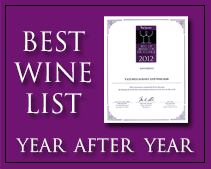Best wine supplier in Philippines discusses wine related topics About Port Wine which is fast becoming a popular wine in Philippines
December 23, 2010
True Port wine comes only from the Douro Valley in Portugal, in the same way that true Champagne only is produced in the district of the same name located some 90 miles east of Paris. And like Champagne, other wines around the world are produced in a similar style to Port, but they are not Port and — while these pretenders may be quite aromatic and flavorful — they fail to capture the delicate balance between complexity and elegance, power and finesse of true Port wines.
Port divides quickly into two different kinds of wine: Vintage Ports and wood Ports Vintage Ports, which account for only two percent of all Port wine made, are wines which age briefly in wood and then spend years maturing patiently in the bottle. Indeed, by law, Vintage Ports must be bottled “between 1 July of the second year following the harvest and 30 June of the third year, counting from the year of the harvest.” In simpler (and more practical) terms, Vintage Port must be bottled two years after the vintage. Wood Ports are defined as everything which is not a Vintage Port. They spend several years aging in the bottle and, by and large, are ready to drink once they reach the marketplace. Wood Ports include such recognizable wines as Ruby, Tawny and White Ports, but also such wines are Vintage Character Ports, LBVs and “Crusted Ports,” as well as the often-misunderstood Colheita Ports.
Vintage Port must say “Vintage Port” (“Vintage Porto”) on the label in big print, on the same line with nothing coming between the two words. This is necessary to distinguish a Vintage Port from the two other types of (Wood) Ports which carry a vintage date on the label (i.e.: LBVs and Colheitas — see below). In general, Vintage Ports are medium-to-full bodied, with a power and richness not found in other forms of Port. While the traditional “rule of thumb” is that Vintage Ports need to be a minimum of 10-15 years of age (from the vintage date) prior to serving, this has never stopped restaurants in America from serving young vintage Ports before their prime. Vintage Ports can age for a considerable time — three to four decades is not an uncommon length of time to age Vintage Ports in one’s cellar.
Most Vintage Ports are produced from a number of different vineyards, one chosen for backbone, one for style, one for bouquet, another for finesse, etc. As with Champagne, the key was in the blending of these various components to create a synergistic whole, better than the sum of its parts. Classically, the one exception to this is Quinta do Noval, which produced its Vintage Port from a single vineyard, or quinta. Recently, several Port producers (more commonly known as a “house” or “lodge”) have begun making single-quinta Vintage Ports. These are generally produced from their best vineyard, but not in their best years. In contrast to the perceptions of most wine drinkers, who (often correctly) believe that a Cabernet from a single vineyard (e.g.: Martha’s) is better than the “regular” Cabernet, single-quinta Vintage Ports — while often excellent — are rarely as good as the “mainstream” Vintage Port from that house. Again, the exception is Quinta do Noval, which only makes a single- quinta Vintage Port, and other small producers which also make their Ports solely from single vineyards (e.g.: Quinta do Crasto, Quinta do Infantado, Quinta de la Rosa).
The major houses began this move toward single-quinta bottlings of Vintage Port to keep up with the increase in the world-wide demand for Vintage Port without increasing the production of Vintage Port, per se. In other words, the majors know their single quintas produce a very good Port, but since it is not the same (nor as good, in classic terms) as their “true” Vintage Port, they do not dilute the world demand (or price) for their Vintage Ports by adding these single quintas to their portfolio. [Note: a list of major houses and their common single-quintas appears as.] Other Port lodges make a Vintage Port in lesser years under a second labelThe difference between a Vintage Port from one producer and another is merely the difference in “house style,” in the same way that the style of a Brut Champagne varies from one house and another. That, and the specific character of each individual vintage. Like a vintage Champagne, Port houses do not declare a vintage every year but only in the best vintages. Certain years are regarded as producing wines which are more “feminine” in style, such as 1975 or 1983, while other years may be viewed as more “masculine” (1977, 1982). Each producer has a characteristic style that remains consistent throughout the entire range — from Ruby through Tawny, all the way to Vintage.
White Ports come into two varieties, dry and sweet. The dry type is relatively new in the overall history of Port and is increasingly popular in Portugal before dinner as an aperitif, in the vein of Lillet or Dubonnet, though it is often compared (incorrectly) to a dry sherry. The sweet type is more traditional and, while it has lost some of its popularity in its native land, it remains a favorite in France and Sweden. Although both types can “hang in there” after bottling, bottle age does not result in any improvement. Indeed, the dry type is frequently hurt by bottle age as the wine loses whatever freshness it had to start with and begins to oxidize. This explains their overall lack of popularity in the U.S. (and the comparison with sherry), which reinforces their sitting around, which reinforces their perception of being oxidized, which reinforces, etc., etc., etc.
Ruby Ports are generally the youngest Port wines offered in a producer’s portfolio. With lush fruit and noticeable sweetness, these are sometimes served lightly chilled as a summer aperitif, or mixed with lemon, it is a popular drink in English pubs. Also, it can be enjoyed with desserts such as fresh pears poached in Port wine and similarly fruity-sweet dishes. While bottle aging does not improve these wines to any noticeable degree (they are ready-to-drink once bottled), there is no need to drink them quickly. They are very stable and last reasonably well after opening.
Tawny Ports are older, lighter in both body and color, and noticeably drier than Rubies. Indeed, the name “Tawny” comes from their mahogany-like hue (just as “Ruby” stems from the bright ruby-garnet color of these young wines). They are usually produced by combining various older Port wines together in a system of fractional blending. This process is different from a Sherry solera, but the two share the idea of mixing the young wine with older wines. There are several kinds of Tawny Ports. The two major kinds include those with no specific statement of age (e.g.: your basic n.v. Tawny Port, a premium bottling of an older Tawny); and, older Ports with a specific statement of age. The only age statements legally permitted are: 10-, 20-, 30- and 40-Year Old Tawny Ports. The older the Tawny, the more pale the color, the more elegant the bouquet, the more delicate the flavor, the drier the style and the more expensive the bottle. Tawny Ports, like Rubies, do not improve with added bottle age and are very stable once opened. Older Tawnies, because of their increased delicacy, are slightly less stable after opening, but only slightly — it is rarely anything to worry about from a restaurant/back bar/home use standpoint.
By the way, a “young” Tawny Port is something of a contradiction in terms, as the name is derived from the color the wine acquires with extended cask aging. Young Tawnies do exist, however, as some Tawny Ports are produced by blending Ruby and White Ports together, thereby achieving the appropriate color. The reason behind this is that, by its very nature, Tawnies are more expensive to produce, given the cost involved in long-term wood aging and in tying up the necessary inventory of stocks in the cellar. Blending Ruby and White Ports together is a cost-effective way of creating a Tawny- style, although it will lack the delicacy of aroma and complexity of taste a true Tawny will achieve.
Tawnies with specific statements of age are still blends. The age statement refers to the average age of the wines in the blend. Thus, a 20-Year Old Tawny Port that was bottled in 1994 will contain wines older than 20 years of age, but will also have some wines younger than 20 years of age.
Another kind of Tawny is the vintage-dated Colheita Port. These are Tawny Ports from a single vintage, for example 1963, but these are not Vintage Ports. Indeed, the use of the word “Vintage” on the label is strictly forbidden in order to avoid any confusion with Vintage Port. Instead of being bottled after two years in wood, as is the case with a true Vintage Port, or bottled between four-and six years as with a Late Bottled Vintage Port (see below), these Tawnies age for extended periods of time in cask. They cannot be bottled before a minimum of seven years of aging in wood, thereby assuring the wine takes on a Tawny quality. A 1963 Colheita Port might be bottled in 1982, 1992 or 1995 — whenever the winemaker decides the wine is ready. A Colheita Port will always bear two dates: the year of harvest and the year of bottling. [This type of Port was once known as “Port of the Vintage” but the confusion between Port of the Vintage and Vintage Port was too great. “Port of the Vintage” is now a forbidden term, but may occasionally turn up on wines bottled prior to 1974 or so.] Also, as some firms feel the word “Colheita” is difficult for non-speakers of Portuguese to pronounce, they have gotten permission to use a new term: “Single Harvest Reserve.” To date, Dow and Warre employ this newer terminology.
Tawny Ports are often served after dinner, either alone or with more delicate desserts that nonetheless are quite flavorful. Shaved chocolate and fresh raspberries, a mocha brownie, cheeses like an aged Gouda or Morbier and blues lighter than Stilton. Dried apricots and other fruits accompanied by walnuts, filberts and unsalted almonds are also quite good.
The final category of wood Ports are those styled to resemble a true Vintage Port. Remember that Vintage Port represents only two percent of all Port wine produced, yet that is the category Americans most treasure. In yet another attempt to satisfy the increased demand for Vintage Port, producers have increased the production of Late-Bottled Vintage and Vintage Character Ports. Late- Bottled Vintage (LBV) Port is a wine produced from a single vintage, and is made like a true Vintage Port in every way save one: instead of being bottled two years after harvest, LBVs are bottled after a minimum of four years and a maximum of six years of aging in cask. Both the vintage date and the bottling date must appear on the label. Also, LBVs must say “Late-Bottled Vintage” clearly on the label to avoid any confusion with a true Vintage Port. Unlike Colheita Ports, these wines retain the full-bodied ripeness and flavors of a true Vintage Port, as opposed to being a Tawny Port from a single year. Unlike Vintage Port, these wines are drinkable when they reach the market and not in need of extensive bottle aging. Unlike other forms of Wood Port, LBVs will improve with moderate bottle aging. Since they are produced in the style of a Vintage Port, in that they possess the character, flavor and depth of a true Vintage Port, they have the “stuffing” for additional bottle age , but since they are somewhat less complex and generally less tannic in their youth (owing in part to their extra aging in cask), this additional age is not a requirement, as it would be with a true Vintage Port.
The aging potential of Late Bottled Vintage Ports can actually vary considerably, depending upon the style of the house and the goals the winemaker(s) has in mind. Those LBVs with the word “Traditional” or “Tradition” appearing on the label have been neither fined nor filtered, and are capable of aging gracefully for several, if not many, years. Wines with no such designation on their label may also age, but it is a bit more of a risk — one does not know if they have been fined and/or filtered to strip out harsh, youthful tannins. This would achieve the goal of early drinkability and enjoyment, but rob the wine of the strength and structure necessary for longevity.
(Mention should be made here of the now-rarely seen “Crusting Port.” This once very popular style is markedly similar in all respects to a Late Bottled Vintage, save for one — it combines two or three wines from vintages which are three to four years of age and, after marrying in cask, bottles the result. Crusting Port is forbidden by law from carrying any reference to a particular vintage and, although capable of improving in the bottle, has largely been replaced by the LBV bottlings, although it is still found in Great Britain. It will improve with some aging, say 5 years or so, and will throw sediment.)
Vintage Character Port is a non-vintage blend of relatively young wines, made in a style to give the consumer the depth and character of a Vintage Port, but without the expense of both money and time. They are smooth, rich and round, with no hard tannins at all in evidence. These wines are ready-to-drink once bottled and generally do not improve with further bottle age, though some aging is not a detriment. They will usually keep better after opening and so often fit the needs of the home where Port is only an occasional after-dinner drink. (For a list of common Vintage Character Port brands.
Vintage Character, LBVs and young Vintage Ports are classically served with Stilton and freshly shelled walnuts, although other blues such as Maytag Blue work quite well. Their more forceful presence also lend themselves to richer chocolate and/or fruit courses than described above, or with coffee/espresso. The older the Vintage Port, the more complex the flavors. Personal preference: I prefer to enjoy older Vintage Port alone — at least for the first glass — and then perhaps a second with a good cigar.
Source: http://www.wineloverspage.com/port/jbl030197.shtml
Are these articles useful for enhancing your wine and dine experience in the Philippines. Do they also help you with travel, leisure, vacation, dining out, nightlife and other leisure activities plans in Manila and other major cities of Philippines? Yats Restaurant hopes to provide you with ample information so you can plan your trips to Pampanga Angeles City Clark Freeport Zone whether you are travelling from Manila or other Asian countries such as Hong Kong, Shanghai, Singapore, Malaysia or Korea.
Restaurant reservations in Manila Philippines, planning of menu, selection of wine for dinner and booking a private function and event in Angeles City Clark Freeport Zone can all be handled. Yats Restaurant and Wine Bar has been regarded by many to be the premier restaurant north of Manila Philippines. Its 3000-line award-winning restaurant wine list has kept many wine lovers happy dining in this restaurant in Angeles City Clark Philippines for over a decade.
Yats Restaurant and Wine Bar was built by Hong Kong-based Yats International in 2000 to provide a world-class cozy fine dining restaurant, business meeting facilities and venues for private dinners and functions in Pampanga Angeles City Clark Freeport Zone. Pampanga Angeles City Clark Philippines was selected for this restaurant because of safety, clean air, absence of traffic and proximity to Manila and Subic.
For comments, inquiries and reservations, email Restaurant@Yats-International.com or call these numbers:
(045) 599-5600 0922-870-5178 0917-520-4401
Http://www.YatsRestaurant.com
Getting to this fine dining restaurant of Angeles City Clark Freeport Zone Pampanga Philippines
How to get to this fine-dining restaurant in Clark Philippines? Once you get to Clark Freeport, go straight until you hit Mimosa. After you enter Mimosa, stay on the left on Mimosa Drive, go past the Holiday Inn and Yats Restaurant (green top, independent 1-storey structure) is on your left. Just past the Yats Restaurant is the London Pub.
Manila visitors and tourists playing golf in Mimosa Clark are surprised to discover good restaurants in Pampanga serving excellent food with fine wines. One of the best restaurants in Pampanga is Yats Restaurant and Wine Bar which has been well regarded by food and wine lovers in Angeles City, Bulacan and Subic as one of the good restaurants in Clark to dine out while visiting Pampanga. This is one of the popular family restaurants in Pampanga that serve really good steaks as well as seafood. Visitors to Clark Philippines rarely pass up in the opportunity to dine at one of the best restaurants in Pampanga.











